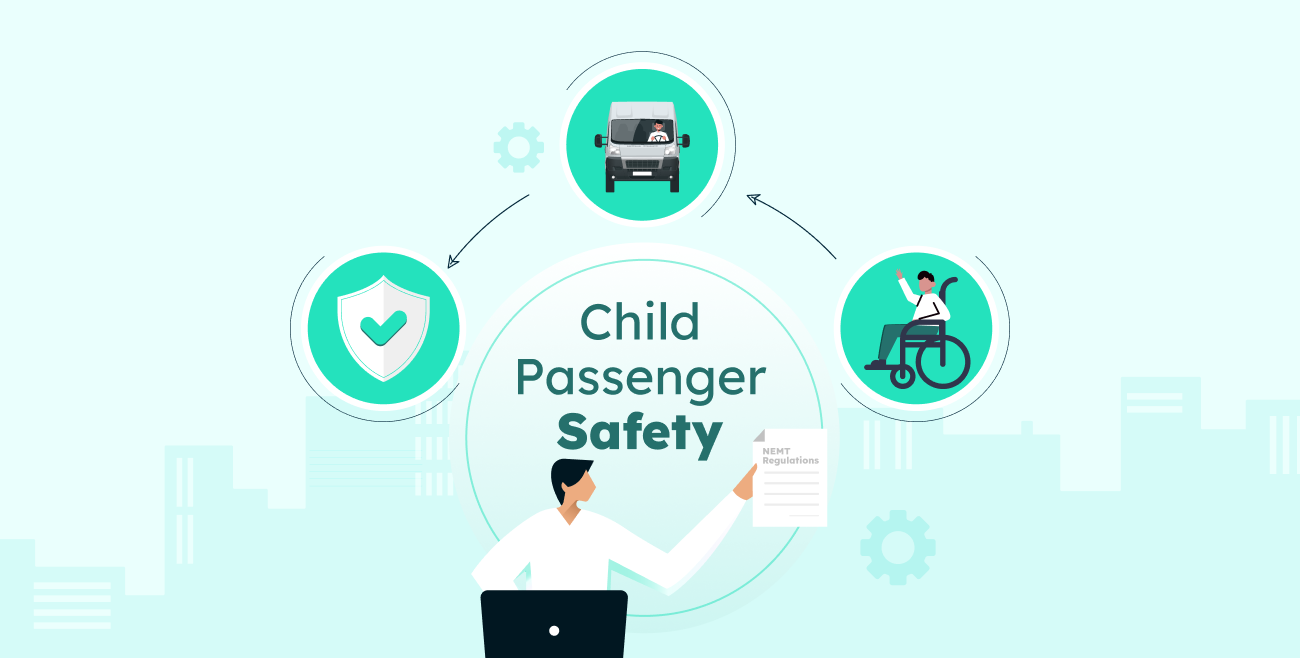
Table of Contents
Non-emergency medical transportation (NEMT) is a critical bridge connecting individuals to essential medical care, specifically when an emergency response is unnecessary.
Children with chronic illnesses, physical disabilities, or developmental issues require frequent medical appointments.
Without reliable transportation, these necessary healthcare visits become challenging and potentially aggravating. NEMT ensures that all children can receive the care they need when they need it.
Consider a child with a weak immune system who faces significant health risks when using public transportation. NEMT provides a sanitized, safe, and private environment for them to travel to and from their treatments.
To better understand how your NEMT business can help safely transport children to and from their appointments, we’ll look at regulations to be familiar with, walk through specific safety tips you can implement, and general guidelines for you and your drivers to follow.
Federal and State Regulations on Child Passenger Safety
Child safety during transportation is a significant concern in the United States. Each year, car crashes injure nearly 250,000 children and claim the lives of almost 2,000.
NEMT providers must prioritize and take full responsibility for ensuring the safety of child passengers.
Research shows that even small things like correctly using child restraint devices can significantly reduce injuries during vehicle incidents. Therefore, an NEMT provider must remain vigilant and committed to child safety.
Do More with Less
Handle more trips with fewer dispatchers on your payroll with Tobi.
Request a DemoCompliance Standards
The National Highway Traffic Safety Administration (NHTSA) and the American Academy of Pediatrics (AAP) have established guidelines for child safety and the selection of appropriate car seats. Responsible transportation providers must adhere to these guidelines to ensure the safety of children in their vehicles.
NHTSA recommendations for child safety features
The NHTSA strongly recommends the incorporation of several child safety features in vehicles, including:
- Side-impact airbags provide additional protection for children in a side-impact collision.
- Child safety locks prevent children from opening doors and exiting the vehicle unexpectedly.
- Anti-pinch/auto-reverse windows: These features prioritize passenger safety by preventing windows from closing on fingers or other objects.
- Seat belts with child safety seat lower anchors secure child safety seats effectively and ensure they are installed correctly.
AAP recommendations for car seat usage
- Infants and toddlers should remain in a rear-facing child safety seat until the age of 2 or until they reach the seat’s weight or height limit.
- Children older than 2, or those who have outgrown the rear-facing limit, should transition to a forward-facing child safety seat with a harness.
- A belt-positioning booster seat is recommended for children surpassing the forward-facing limit until the vehicle lap and shoulder seat belt fit correctly, typically around 4 feet 9 inches in height and between 8 and 12 years of age.
State-specific regulations
While adhering to NHTSA and AAP guidelines is essential, compliance with state regulations is also crucial.
State regulations are often more stringent than federal guidelines and cater to local needs and safety concerns.
Transportation providers must be aware of and comply with all applicable state regulations to ensure the safety of their child passengers.
Looking closely at state laws, we see a list of requirements catering to various age, weight, and height categories. For instance, very young children and infants must be in rear-facing car seats in Alaska.
At the same time, those between four and eight years old and within certain weight and height parameters must use a booster seat—similar stipulations exist in other states with guidelines to ensure child passenger safety.
Monitoring Child Safety
NEMT providers are the last line of defense in securing young passengers before any journey begins.
While guidelines to better protect children exist, it’s everyday practices that bring these guidelines to life, such as:
- Double-check that children are securely fastened in age and size-appropriate restraints.
- Use rear-facing car seats when needed for enhanced protection.
- Ensure children wear seatbelts if they’re no longer in a child seat.
NEMT Providers and Car Seats
According to the NHTSA, car seats can reduce the risk of fatal injury in children by 71% for infants and 54% for toddlers.
Penalties for non-compliance can be substantial, not only in fines but in the potential for harm to young passengers. Thus, maintaining up-to-date knowledge of these regulations and transporting every child passenger correctly according to age, height, and weight is a legal obligation and a commitment to safety.
To help transport children safely, click this link to know each state’s laws on car seats.
Keeping Kids Safe During Transportation
The NHTSA provides crucial advice on preventing dangers. While not all guidelines are relevant to NEMT providers, they most certainly apply.
Power Window Safety
Children can easily injure their fingers, hands, and arms while playing with power windows. Some children have even been strangled.
Ensure children do not play with window switches, always check for children’s extremities before closing windows, and activate window locks if available.
Seat Belt Entanglement
A seat belt can become a hazard if a child plays with it and gets entangled, potentially leading to injury or worse.
Always ensure children are properly restrained and do not play with seat belts. Buckle unused seat belts to prevent children from playing with them.
Car Seats
Car seats are essential and mandated by law when transporting infants, toddlers, or young children.
Standard seatbelts are inappropriate for young children and may cause injury if there is some incident. Car seats help reduce the risk of injury.
Safe Driving Behavior
Practicing safe driving behavior is essential to ensuring the safety of child passengers.
When drivers follow all road safety guidelines, minimize crossing lines of traffic, and have a clear line of communication with the central office, this helps enhance the safety of child and adult passengers.
For more detailed information and resources, visit the NHTSA’s website.
General Guidelines for NEMT Providers
Ensuring vehicles meet ADA accessibility standards is essential for providing inclusive transportation services.
This commitment to accessibility means that every passenger, regardless of physical ability, can travel with ease and dignity. Also, a well-maintained climate control system with adequate heating and cooling systems is indispensable for maintaining a pleasant environment during the trip.
Seat Belts
Safety is paramount, and this is reflected in the requirement for fully operational seat belts for all seating positions, alongside secure belts for wheelchairs, ensuring that all passengers are safely restrained during their journey.
In an emergency, the quick availability of a seat belt cutter in each vehicle is a critical safety measure, allowing for fast response in situations where every second counts.
Driver Requirements
Drivers must possess at least two years’ driving experience, be over 18, and hold a valid driver’s license.
Before transporting passengers, they must complete a Passenger Service and Safety (PASS) course.
The role extends beyond driving as active assistance is mandatory for drivers or attendants providing personalized door-to-door service.
An in-depth knowledge of local geography and HIPPA laws is essential for providing compliant, efficient, and prompt transportation services.
First-Aid Kit
The presence of a stocked first aid kit in each vehicle is a testament to the provider’s preparedness to handle minor health emergencies that may occur during transit, ensuring that the well-being of passengers is always a top priority.
Vehicle Maintenance
The condition of the vehicle is a direct reflection of the quality of service provided.
Keeping vehicles clean and in good repair, free from excessive dirt, damage, or grime, speaks volumes about the standards upheld by the service provider.
Safety also means maintaining an interior free from hazardous debris and unsecured items.
A clutter-free vehicle not only ensures the comfort and safety of passengers but also adheres to stringent safety regulations.
Professional Appearance
Professionalism is non-negotiable, with expectations of courtesy, patience, and a well-groomed appearance.
It’s further enhanced by clearly displaying the provider’s business name and contact information on the vehicle’s exterior.
This ensures easy recognition and instills confidence in the service businesses provide.
Tobi Helps You Focus More on What Matters
What if you could spend more time focused on the safety and experience of your passengers rather than booking rides and managing schedules?
Tobi enhances your operations, making the day-to-day tasks of NEMT providers simpler. It’s easy to use, so staff members spend less time learning the software and more time serving clients.
Plus, Tobi streamlines billing, reducing paperwork and errors.
Are you curious how Tobi can help you run your NEMT operations more efficiently? Request a demo and experience how Tobi makes your business better at every turn.



